10 Parts Of Harry Potter And The Deathly Hallows Part 2 That Are Actually Better Than The Book
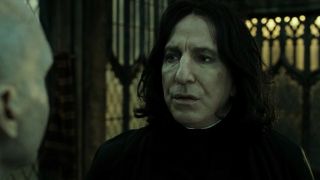
The two Harry Potter and the Deathly Hallows films have been among the most true to the books, spreading the story out over two films and allowing director David Yates and screenwriter Steve Kloves to keep nearly everything they wanted to. But there are always changes big and small made between book and film, and Deathly Hallows Part 2 has some significant ones, from a big confrontation between Harry and Snape in the Great Hall to the strategic destruction of a bridge at Hogwarts that doesn't even exist in the books.
As I wrote in my review, these changes help make Deathly Hallows Part 2 one of the best of the Potter films, and one of the most interesting as a standalone experience. I don't love all the changes, and I'm not trying to record all of them here-- there are plenty of big differences between the book and the movie that aren't on this list. But below are 10 of the changes that I think actually improve on what was there in the book, helping streamline the story or give more emphasis to characters as they experience big, life-changing moments. I don't think Harry Potter and the Deathly Hallows Part 2 overall is better than the book-- for me, none of the movies have ever reached that mark-- but these 10 individual moments definitely are. Read below for the 10 best changes and let me know in the comments where you stand on the filmmakers tinkering with the words and story of J.K. Rowling.
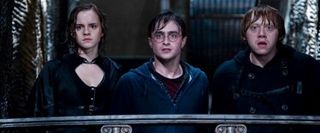
It's Hermione's idea, not Harry's, to release the dragon at Gringotts. This is a small change but a big one. Hermione is always the one with the good but practical ideas in the books, and it's reckless Harry who comes up with the idea of releasing the dragon and riding it to safety out of Gringotts. But why not let Hermione say "I've got one idea, but it's mad" then jump on the dragon's back anyway? It makes the trio seem more like equals and shows that rarely seen side of Hermione that's willing to take a risk.
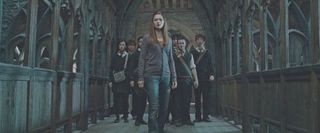
The destruction of the bridge scene. The filmmakers spent so much time condensing the Battle of Hogwarts that they get away with actually adding a scene, and it helps that it's a great one. Neville is charged by Professor McGonagall to blow up the rickety bridge leading into Hogwarts, and after taunting some Death Eaters just outside the invisible bubble of protection, he flees when that protection breaks and blows up the bridge just in time to send the Death Eaters to their deaths-- and crawl back up from the brink with a hero's ease. It's a fun, dramatic scene that works fantastic on film, and sets up both Neville's later heroics with the sword of Gryffindor and Luna Lovegood's newfound romantic interest in him. It probably wouldn't have worked as well in the book, which is much more locked into Harry's perspective, but it's brilliant here.
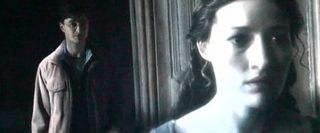
Focusing Harry's hunt for the diadem on his conversation with the Gray Lady and not going to Ravenclaw Tower. This change probably gives the biggest sense that the action of the Battle of Hogwarts has been condensed and tightened. Instead of going up to Ravenclaw Tower to get a look at the diadem on a statue of Rowena Ravenclaw, then getting caught by the Carrow twins and almost ratted out to Voldemort, Harry simply goes directly to the Gray Lady ghost on Luna Lovegood's advice. The Carrow scene would have been dramatic, sure, but there's plenty more drama to go around, and introducing those two new characters would have taken up valuable time that needed to go to the characters we already know.

Snape and Harry face off in the Great Hall. This is probably the most dramatically different scene from anything that happens in the book, taking what was written as a hallway confrontation between Professors McGonagall and Snape, Harry hidden in an invisibility cloak, to a showdown in the Great Hall in front of everyone. This way we get rid of Harry needing to keep his presence secret, which becomes a moot point anyway once Voldemort starts attacking the castle, and Harry finally gets to have his big moment outing Snape-- which, of course, will make him feel even guiltier when learning Snape's back story later in the movie. Plus we still get awesome McGonagall and Snape dueling to go with it. Oh, and speaking of McGonagall…
CINEMABLEND NEWSLETTER
Your Daily Blend of Entertainment News
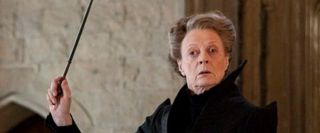
More emphasis on Professor McGonagall. It might not actually be true that Professor McGonagall gets more lines in the movie than she does in the book, but some combination of Maggie Smith's imposing presence and the way the story is condensed means the head of Gryffindor House feels like one of the main figures during the Battle of Hogwarts. So many of the adult actors playing professors in the Harry Potter movies just get to pop in for quick cameos-- hey there, Jim Broadbent and Emma Thompson!-- but Smith gets to take this one over, and it's as good to see her command the scene as it is to see Professor McGonagall protect the castle she loves.

Not revealing Fred Weasley's death until the action is over. In the book Fred Weasley's death is one of the many terrible things that Harry has to comprehend almost instantly and run on, for his own survival. The way Rowling tucks it in right after the fiery scene at the Room of Requirement helps emphasize the chaos and danger of battle, but in the movie, it would have slowed down the action and not given Fred the send-off he deserved. Instead, the movie waits until Harry, Ron and Hermione visit the Great Hall and see the many families tending to their dead, a quieter moment when Ron is allowed to mourn-- and so is the audience. It's a small switch that makes a big difference.
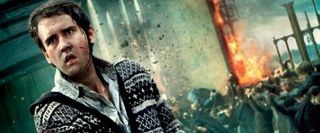
More focus on Neville's triumphant moment against the snake. Neville's long-awaited moment of triumph in this battle comes at a fairly chaotic moment in the book-- J.K. Rowling actually writes, "And then many things happened at the same moment." As the boy who also could have been the one mentioned in the prophecy that caused Voldemort to kill Harry's parents, Neville always seemed destined to have a heroic moment of his own, and in the movie version of Deathly Hallows he spends much more time building his way up to it, taking charge of the sword of Gryffindor and finding his way to Nagini, the snake that's actively threatening Hermione's life when he kills it. You could argue it's a little overdone, but those of us who have been rooting for Neville were thrilled to finally see him get his true Gryffindor triumph.

Actually seeing Ron and Hermione get the basilisk fangs. It's the culmination of the book's greatest long-running romance (sorry, Harry and Ginny) and Ron's greatest opportunity to prove he's just as good at heroics as Harry, and yet in the Deathly Hallows book it all takes place offscreen while we focus on Harry's search for the lost Ravenclaw diadem. Not only is the trip back down to the Chamber of Secrets a nice nostalgic visit for fans of the movies, but Ron and Hermione's surprised kiss afterwards is the cinematic moment we've all wanted for them-- even if they were soaking wet and surrounded by a basilisk skeleton as it happened.

Less focus on the Dumbledore family drama. Harry's search into Dumbledore's backstory-- Dumbledore's friendship with Grindelwald, his relationship with his brother Aberforth, and especially his dead sister Ariana-- took up a stunning amount of the book, and though it led to an interesting theme about accepting that your heroes are human beings, it also often felt like a distraction. There are still remnants of that subplot in the two Deathly Hallows movies, particularly in the first one as we learn about the Hallows, but it's pretty well muted in this one, even when we finally meet Aberforth at the Hog's Head Inn. It makes the biggest difference in the King's Cross scene between Harry and Dumbledore when Harry is technically dead; in the book Dumbledore spends a long, long time explaining his life story, how Ariana's death impacted him and why he spent so long looking for the Hallows. In the movie, the focus is on Harry, where it really should be. It's true that Harry's interest in Dumbledore's history just kind of peters out in Part 2-- I'm never going to argue these movies are consistent in their character threads-- but it is a relief not to be bogged down by it as much this time when the movies clearly had no intention of fully telling Dumbledore's story.

The many locations, and the few words, of Harry and Voldemort's final battle. There's probably a stage play to be made of Harry and Voldemort's showdown as written in the book, just two men circling each other with their wands, talking at length about wand lore and their own personal histories and taunting each other-- My Dinner With Voldy? It's great reading but never would have worked onscreen, and as established in the movies Voldemort is more of a man of action, unlikely to taunt and chat with Harry instead of just "Avada Kedavra"-ing and getting out of there. The filmmakers don't just turn this into a big action sequence, but invest it with meaning by sending Harry and Voldemort running all over the destroyed Hogwarts grounds, from the courtyard where Harry watched Hedwig fly away at the end of the first movie to the observatory deck where he watched Dumbledore die. It's a great use of cinema's visual power, and it saves all the explanation of the Elder Wand and its allegiances for a coda afterwards, letting Voldemort's death be a little unexplainable while it's happening-- kind of like the man himself.
Staff Writer at CinemaBlend
Most Popular





